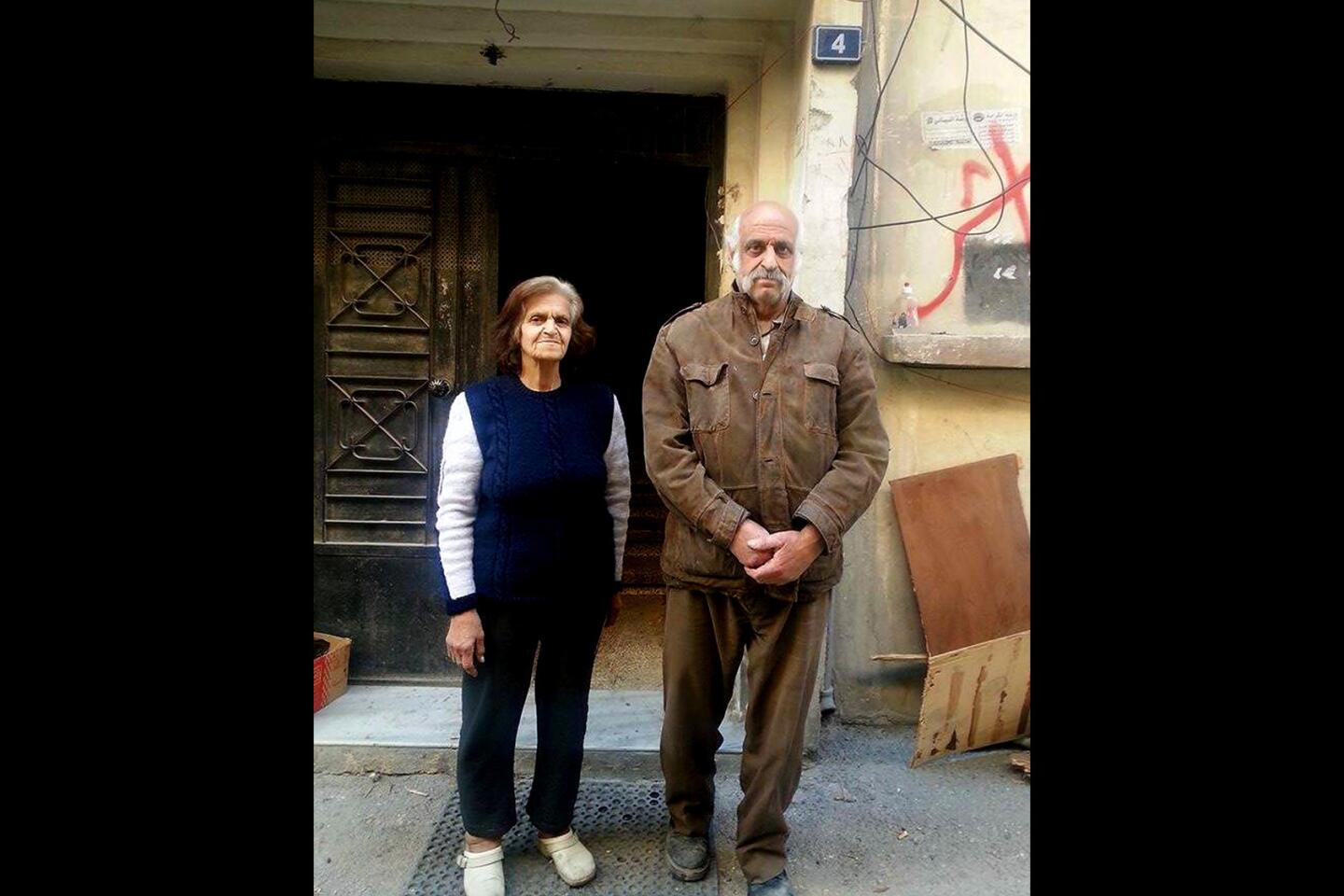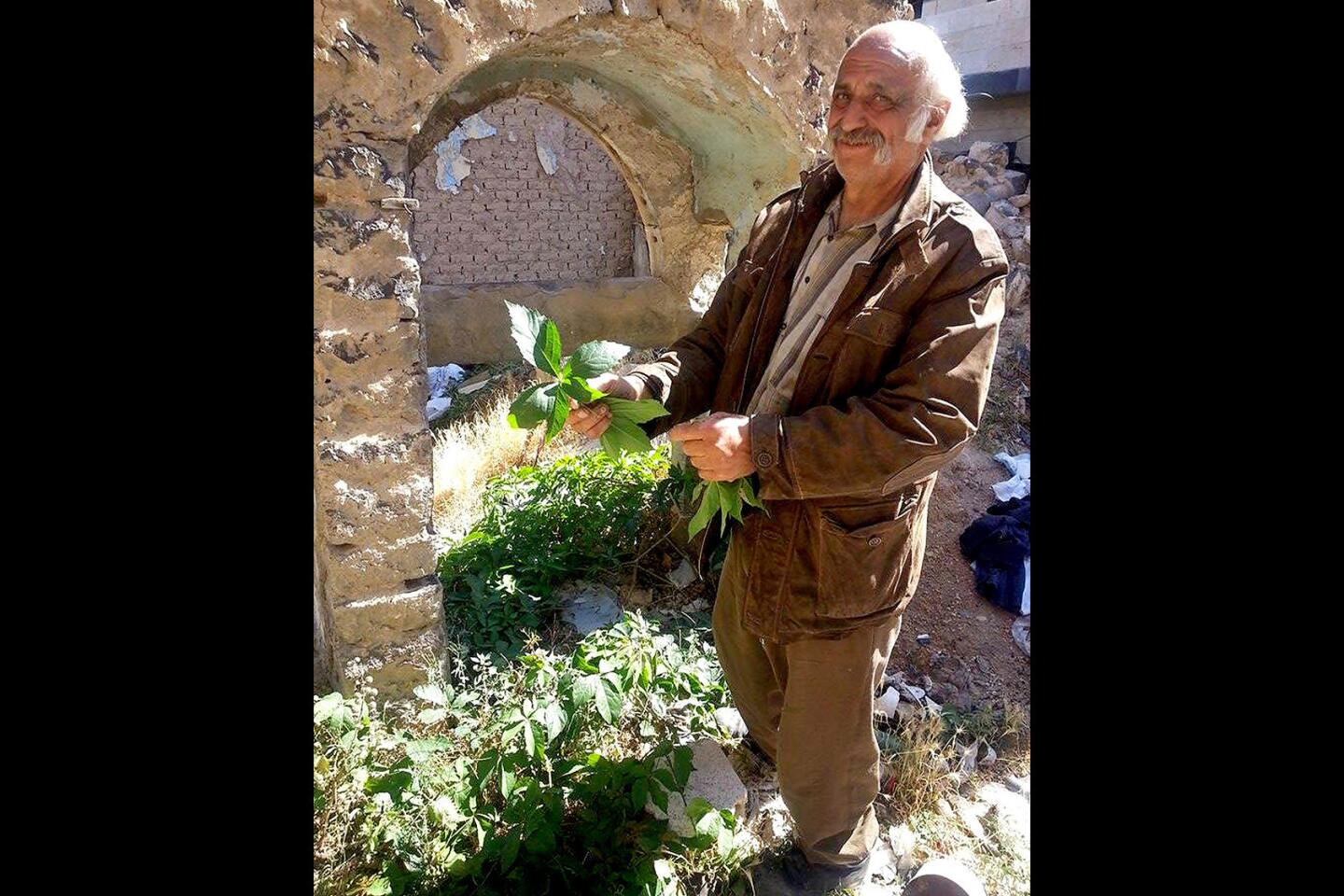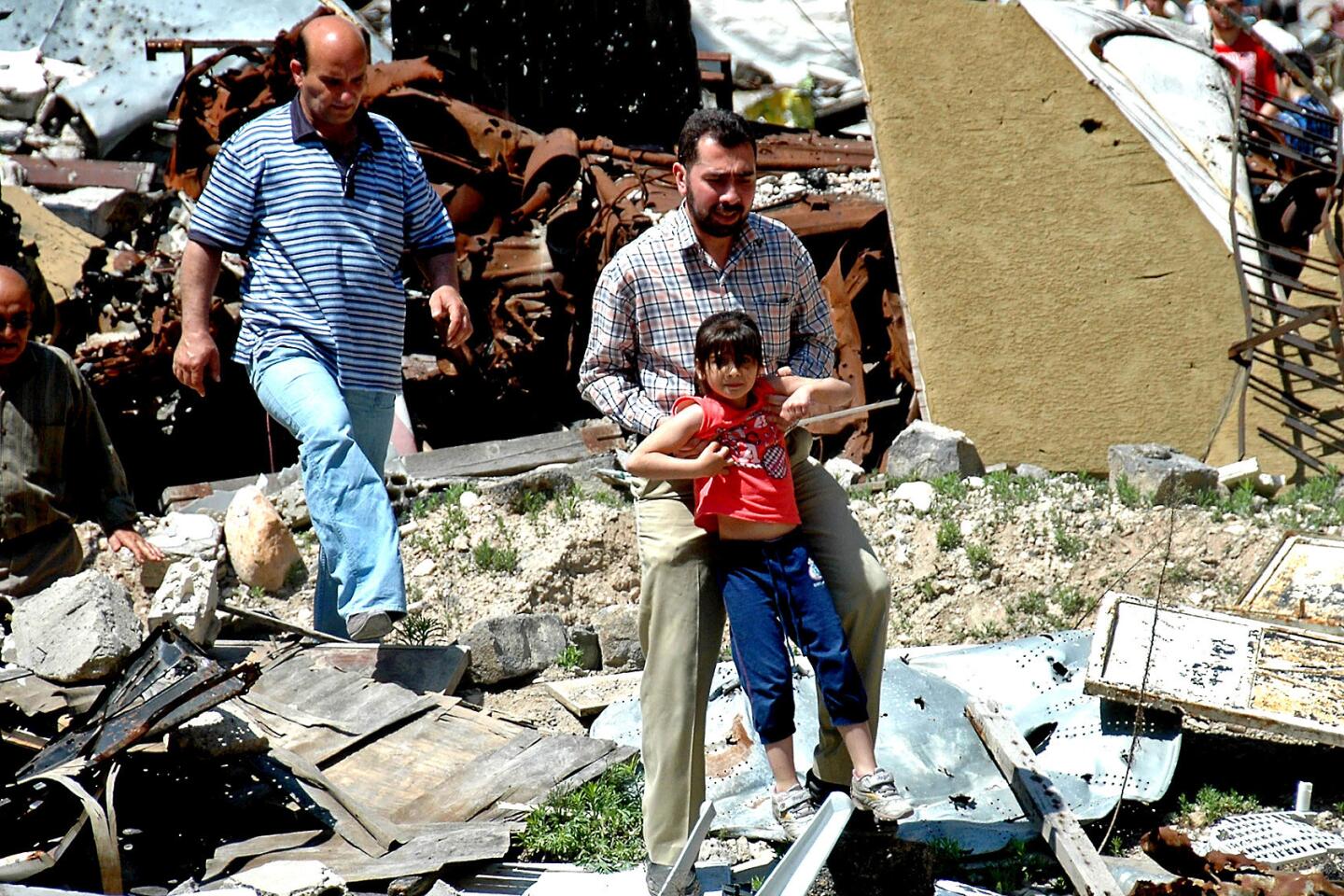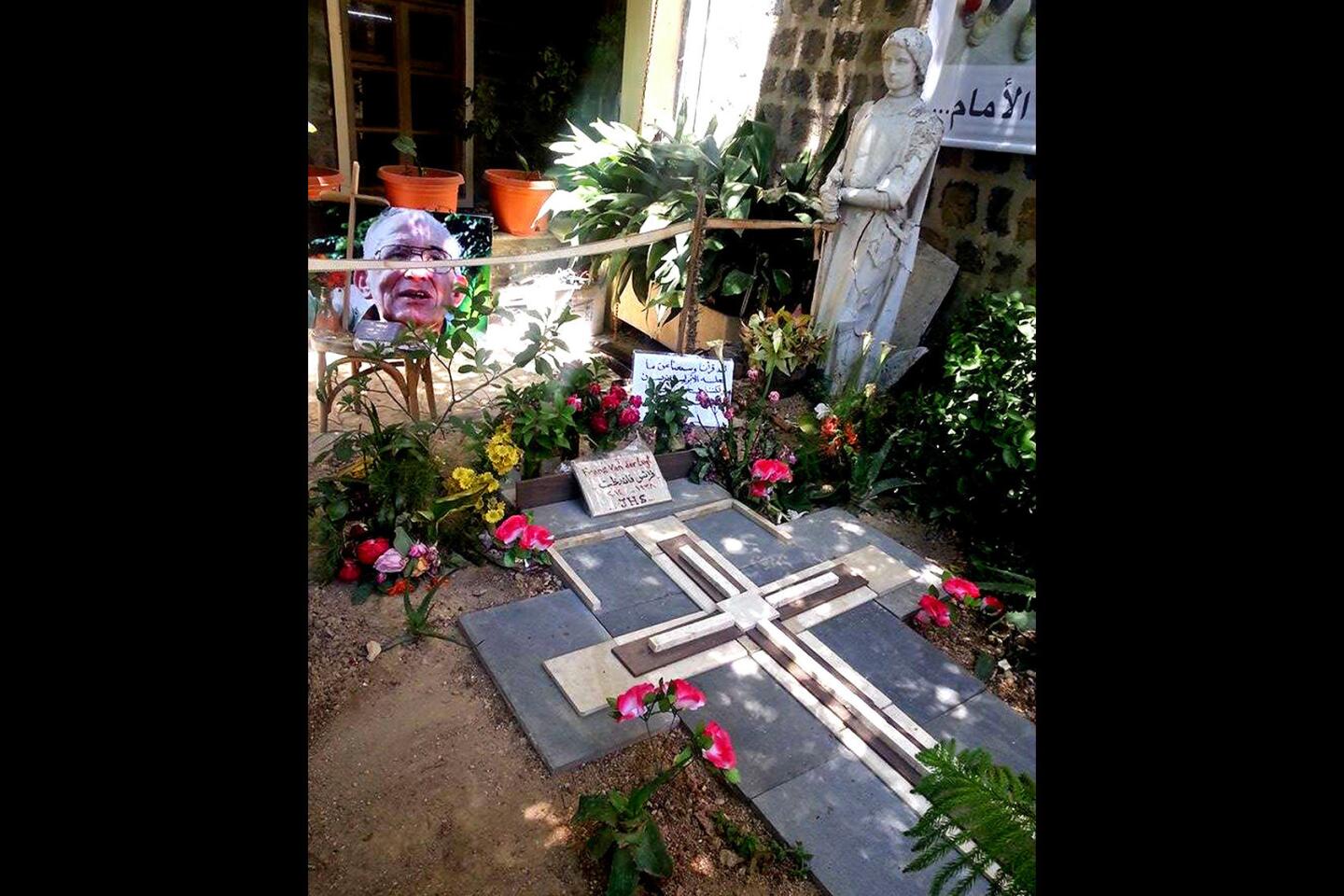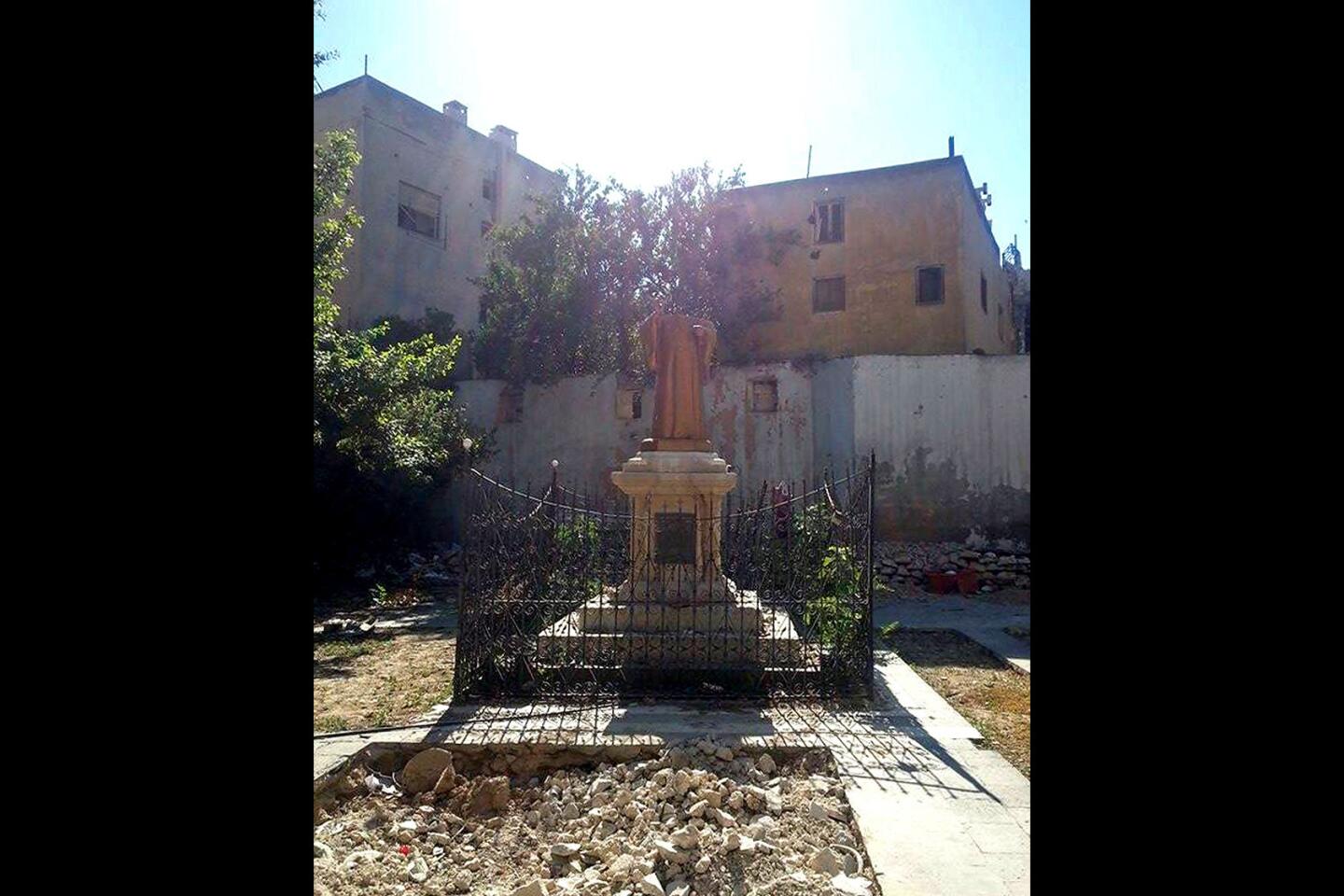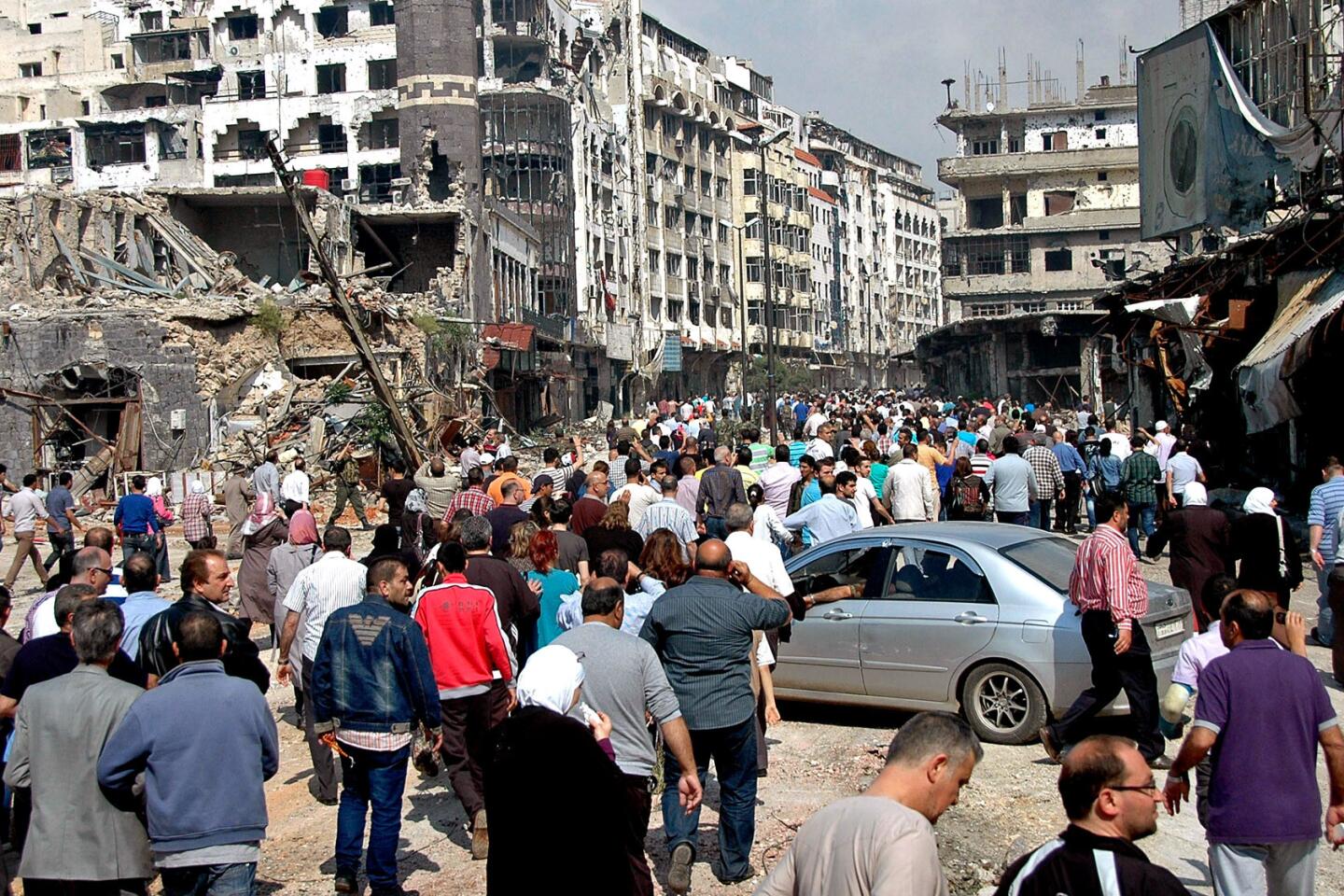Great Read: During Syrian siege, siblings honed the art of improvised survival
- Share via
Reporting from HOMS, Syria — Sobhi Fares ducks beneath the battered arches of a once-grand Ottoman villa. His trained eyes scan for shoots of green that spring improbably from the clutter of shattered masonry, tumbled walls and jagged shards of shrapnel.
“This one, here, you can wash it and eat it raw — but it is better with a little oil,” he says, fingering a clump of basil-like leaves. “And this,” he adds, baring spiky sprigs of purple and pale green reminiscent of chicory, “this you can chop into little pieces and add some seasoning.”
Fares, 61, is a survivor of the punishing government siege here. For nearly two years, he lived without running water, electricity or shops; the prospect of death from shelling or snipers never receded. He is a man who has emerged from the rubble physically intact, though spiritually damaged. Tears come easily to his eyes.
His urban gardens amid the Armageddon of Homs’ Old City helped sustain him and his older sister, Antoinette, during the time of hunger, persistent militant bombardments and periodic raids by cornered Islamist rebels who sacked and burned abandoned homes, churches and shops.
Tales of survival are beginning to rise from Homs’ rubble in the aftermath of a deal that allowed about 2,000 remaining rebels to evacuate the Old City this month, and also opened the way for civilians to return. Longtime residents who fled have been streaming back, stunned by the scope of destruction and , anguished by the damage to their homes, but relieved that they are no longer shut out.
Amid the debris and chaos, a visitor occasionally catches a glimpse of a ghostly figure with hollowed-out eyes, clothing drooping from a body shrunken from insufficient calories. Such are the ones who stayed behind.
::
Just how many civilians braved the siege is not known. Perhaps two dozen people, most of them elderly, refused to leave Homs’ ancient Christian quarter in the Old City, once home to tens of thousands of people and a dozen or so churches.
The Fares siblings opted to stick it out to the end. They had been happy in their cozy basement apartment on a narrow street. They didn’t want rebel squatters and looters to trash or burn their home, the fate of so many residences here. Nor did they want to be a burden to relatives
“We just couldn’t find it in ourselves to abandon everything,” says Antoinette, 65, a petite woman with a deeply lined face and an easy smile. She lost 70 pounds, almost half her body weight, during the siege. “Once you left, they would come and everything would be destroyed.”
She hastens to offer coffee to visitors, heated on a makeshift burner designed by her brother, a carpenter who is also an inveterate tinkerer and hoarder of provisions — traits that served the two well. “May I invite you for lunch?” she inquires, displaying a pot of stew with vegetables and meat, unheard of luxuries for so long.
The Fareses are proud people and hesitant to dwell on their ordeal, particularly the humiliations they endured. They initially decline to be photographed, worrying that they would appear unseemly in their now-baggy and rumpled clothes.
Their two-bedroom flat is what might be called comfortably cluttered: walls adorned with photographs and prints, including a photo of a deceased older brother, Antoine, and a print of Jesus at the Last Supper; tables, shelves and chairs decked out with all matter of trinkets and baubles, from stylized glass trees to plastic Easter eggs to several aging and dusty Santa Clauses. The entrance stairway is stacked with boxes of stuff. The place is assuredly lived in.
“Two years ago, we almost did leave,” says Antoinette, a bit apologetic at the memory. A quirk of fate altered their plans, and changed their lives.
“The car that was to take us to leave was late,” Antoinette continues, savoring a cigarette. “And then I decided, No, we’ll stay.”
::
Early on, they say, rebels forced their way in and robbed them of most of Sobhi’s stores of bulgur wheat, oil, sugar, fat and other staples. So they lived frugally on what remained, the bits of sustenance they could scrape together and the wild plants of urban Homs. Sobhi became a proficient forager, rummaging for food, wood and other essentials.
Some black-market items were available, but at exorbitant prices. A single cigarette cost the equivalent of at least $20.
For water, Sobhi trekked with plastic bottles to several wells in the Old City, including one in the yard of the nearby Church of the 40 Holy Martyrs. The water had to be boiled.
On the church grounds, Islamic fighters planted a garden with tomatoes and herbs for themselves and their families. They also chopped off the head of the statue of a bearded Orthodox patriarch — having rejected the artwork as idolatry. The disembodied head remains on the ground, one more chunk of debris.
“The last few months were especially difficult,” says Antoinette, dressed in a tracksuit and clogs. “We were all desperate for food.”
Their relationship with the insurgents was always uneasy. Exchanges generally did not go beyond “good morning” or “good afternoon.” There was an embedded tension: Christians are generally regarded as pro-government.
“We didn’t want to ask too many questions,” Sobhi says of the rebels. “They might think we were spying on them.”
But apart from barging in to steal food, the couple said, the gunmen generally left them alone. The pair never went out at the same time; someone was always home to discourage looting. For the one who stayed home, there were always anxious moments until the other returned safely.
Still, Sobhi ventured out on his daily quests for essentials, and both regularly visited the nearby Jesuit residence, where an elderly Dutch priest, Father Frans van der Lugt, welcomed the trapped of all creeds and provided food when he could.
The two slept in a back room of their flat, away from the windows onto the street above. They avoided drawing undue attention.
It seems improbable that either could have made it without the other. They appear like an aging married couple, fully in sync with each other’s needs and movements, exuding mutual affection. Neither ever married.
Over the months, they spent long hours playing cards, trading limited news of the world with other marooned Christians, listening to music on a transistor radio that functioned sporadically. Sobhi collected stray batteries discarded by rebels, who had used them for their walkie-talkies. He had to jury-rig the radio to adapt to the AA size.
“Some people are jealous of us. They wonder why we are so happy together,” says Sobhi, still an imposing presence after dropping 60 pounds.
A drooping gray mustache accentuates a sense of melancholy in his dignified bearing. When first asked about the siege, Sobhi seizes up, tears clouding his eyes and his mouth clenching. But he becomes animated when talking about the art of improvised survival.
The craftsman can’t conceal his pride of invention — like the candles, the only source of light after dark.
“We collected the melted wax and reused it,” he explains, showing a visitor an ingenious contraption made from plastic tubes cut candle-size and set into a block of wood. Melted wax was stuffed into the makeshift molds, a bit of oil added to provide lubrication, and a piece of fabric inserted for use as a wick. Legs of chairs were fashioned into candlesticks.
Coffee was brewed on a portable burner composed of an ashtray fueled by cotton drenched in arak, an anise-flavored liquor. The alcohol burns well.
For heat in the cold months, Sobhi converted a kerosene stove to a wood-burning variant. In a narrow outdoor space out the back door, he constructed a more ample wood stove for cooking, topped by a sheet of iron that served as a hot plate. Efforts to grow parsley and tomatoes in plastic tubs out back didn’t yield much.
The darkest day of the ordeal was April 7, with its unfathomable news: A masked gunman had killed Father Van der Lugt in the refuge that was the garden of the Jesuit residence. But, as the devastated siblings and others mourned their benefactor, rumors were already spreading that the gunmen were preparing to withdraw.
::
In early May, rebels came to the Fares’ apartment and demanded suitcases and backpacks.
“We told them we didn’t have anything like that,” Antoinette says. “We couldn’t go anywhere. Why would we have such things?”
On the streets outside, movement among the fighters accelerated. The siblings lay low in their dimly lighted flat. It wasn’t until a knock on their door that the pair realized they were no longer captives.
It was their sister, Janette, who lives outside the Old City. There were few words amid joyful embraces, tears and a final realization that they had survived.
Returning neighbors, seeking to assess damage to their property, said they were astonished that the siblings were still alive.
“I look forward to this place being like it used to be,” says Sobhi, savoring the renewed bustle in the narrow streets of his Bustan al Diwan district. “The life coming back.”
Although the top floor of the siblings’ three-story concrete building was hit by a shell, their home seems structurally sound.
The siblings themselves appear more fragile. Even an outsider can sense a distance between them and the returnees. The pair are uncomfortable in the role of celebrated survivors, having lived through something ineffable, too powerful for words to capture.
Sobhi is now free to roam about the bombed-out cityscape without fear of government shelling or marauding rebels. Still, his meanderings inevitably take him by his secret gardens. His eyes wander to the tangles of vegetation.
“I had some of this yesterday,” he says, fingering a sliver of green yanked from the bush. “It tastes like grape leaves.”
He wanders back toward the basement flat where Antoinette waits. It is almost supper time, and there is beef stew on the stove. There is no longer any need to scour for sustenance amid the wreckage of this broken city.
More to Read
Sign up for Essential California
The most important California stories and recommendations in your inbox every morning.
You may occasionally receive promotional content from the Los Angeles Times.
